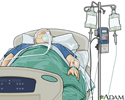Sepsis
Septicemia; Sepsis syndrome; Systemic inflammatory response syndrome; SIRS; Septic shock
Sepsis is an illness in which the body has a severe, inflammatory response to bacteria or other germs.
Causes
The symptoms of sepsis are not caused by the germs themselves. Instead, chemicals the body releases cause the response.
A bacterial infection anywhere in the body may set off the response that leads to sepsis. Common places where an infection might start include the:
- Bloodstream
- Bones (common in children)
- Bowel (usually seen with peritonitis)
- Kidneys (upper urinary tract infection, pyelonephritis or urosepsis)
- Lining of the brain (meningitis)
- Liver or gallbladder
- Lungs (bacterial pneumonia)
- Skin (cellulitis)
For people in or recently discharged from the hospital, common sites of infection include intravenous lines, surgical wounds, surgical drains, and sites of skin breakdown, known as bedsores or pressure ulcers.
Sepsis most commonly affects infants or older adults.
Symptoms
In a person with sepsis, the blood pressure drops, resulting in shock (the inability to provide necessary blood perfusion to all of the organs in the body). Major organs and body systems, including the kidneys, liver, lungs, and central nervous system may stop working properly because of poor blood flow.
A change in mental status and very fast breathing may be the earliest signs of sepsis.
In general, symptoms of sepsis can include:
- Chills
- Confusion or delirium
- Fever or low body temperature (hypothermia)
- Lightheadedness due to low blood pressure
- Rapid heartbeat
- Skin rash or mottled skin
- Warm skin
Exams and Tests
Your health care provider will examine you and ask about your medical history.
The infection is often confirmed by a blood test. But a blood test may not reveal infection in people who have been receiving antibiotics. Some infections that can cause sepsis cannot be diagnosed by a blood test.
Other tests that may be done include:
- Blood gases
- Kidney function tests
- Platelet count, fibrin degradation products, and coagulation times (PT and PTT) to check for bleeding risk
- Complete blood cell count (CBC)
- White blood cell differential
Treatment
A person with sepsis will be admitted to a hospital, usually in the intensive care unit (ICU). Antibiotics are usually given through a vein (intravenously) and need to be given as quickly as possible.
Other medical treatments include:
- Oxygen to help with breathing
- Fluids given through a vein
- Medicines that increase blood pressure
- Dialysis if there is kidney failure
- A breathing machine (mechanical ventilation) if there is lung failure
Outlook (Prognosis)
Sepsis is often life threatening, especially in people with a weak immune system or a long-term (chronic) illness.
Damage caused by a decrease in blood flow to vital organs such as the brain, heart, and kidneys may take time to improve. There may be long-term problems with these organs.
Prevention
The risk of sepsis can be reduced by getting all recommended vaccines.
In the hospital, careful hand washing can help prevent hospital-acquired infections that lead to sepsis. Prompt removal of urinary catheters and IV lines when they are no longer needed can also help prevent infections that lead to sepsis.
References
Gordon AC, Russell JA. Shock syndromes related to sepsis. In: Goldman L, Cooney KA, eds. Goldman-Cecil Medicine. 27th ed. Philadelphia, PA: Elsevier; 2024:chap 94.
Shapiro NI, Jones AE. Sepsis syndrome. In: Walls RM, ed. Rosen's Emergency Medicine: Concepts and Clinical Practice. 10th ed. Philadelphia, PA: Elsevier; 2023:chap 127.
van der Poll T, Wiersinga WJ. Sepsis and septic shock. In: Bennett JE, Dolin R, Blaser MJ, eds. Mandell, Douglas, and Bennett's Principles and Practice of Infectious Diseases. 9th ed. Philadelphia, PA: Elsevier; 2020:chap 73.
Review Date: 8/29/2024




















